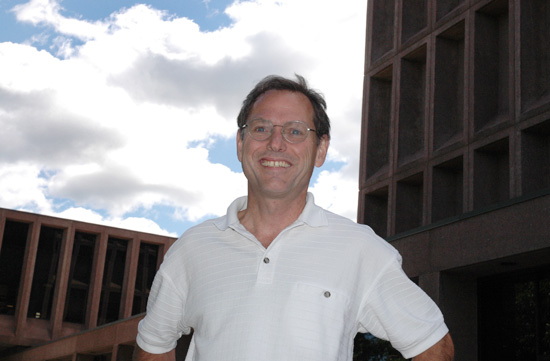Analyst-Programmer Career Spans 3 Decades of Computer Technology
 |
| Dan Koepf, analyst-programmer for Information Technology Services – Student Services, is responsible for the design, analysis, creation, modification, testing and maintenance of software application programs for several departments on campus. |
| Posted 09/19/07 |
| When Dan Koepf began his career in Information Technology Services, Wesleyan was using only a couple of computers university-wide. Today, there are more than 1,250 personal computers, 447 special-purpose computers and 33 research and teaching computers in use on Wesleyans campus. And this excludes the hundreds of personal computers and laptops owned and used by students in their residences.
It has been an amazing experience to witness all the changes during my 28 years at Wesleyan, says analyst/programmer Koepf. Its hard to believe, but there was a time when we didnt have PCs, the internet, or fiber-optic wire. We used a lot of paper back then. When Koepf started his programming career at Wesleyan, the university had about 25 dumb terminals operating in the Wesleyan Computing Center, ITSs predecessor. One was used by the Office of the Registrar, and one by the Office of Admission. These machines consisted of a keyboard and monitor but lacked an independent processing unit. Through a twisted-pair wire, similar to a telephone line, keystrokes could be sent from these terminals to the computing center, located on the fifth floor of Exley Science Center. But you couldnt send files, of course, and since we were the only department with a printer, we would be the ones printing reports and shipping them to departments on campus, Koepf explains. Now most printing is done locally. At the time, Koepf was one of three programmers and four key-punchers for the administrative computing side of the Wesleyan Computing Center. One of his first jobs was to upgrade and reprogram the Payroll Departments system. Back then, every employees payroll information was on a punchcard, and when it was time for us to get paid, theyd just run all the cards through a machine, Koepf explains. Then, theyd run another stack of cards through the machine that had our tax and health care deductions on them, and then it would calculate what our checks would be. It was quite a process. In addition, he wrote programs for the Admission and Registrar offices using the Common Business-Orientated Language, or COBOL, and later upgraded to a program called System 1022, and 1032, which required learning a different programming language. Wesleyan acquired its first personal computers, stand-alone machines that can process and store individual information, in 1985. These AT&T PC 6300s were the first computers available for sale in the Wesleyans Microcomputer Center, at the very affordable price of $1,886.63, according to a September 1985 Wesleyan Computing Center newsletter. With the advent of personal computing in dorms and offices, there are sure to be changes in Wesleyan, it reported. Times have changed, but Koepfs role remains essentially the same, though more expansive in its scope. As an analyst-programmer, Koepf has always been responsible for the design, analysis, creation, modification, usability testing and maintenance of software application programs or databases for individual departments. Ten years ago, Wesleyan programmers stopped developing new systems from scratch, and purchased the Web-based, database application software, PeopleSoft. PeopleSoft still requires programming to create individualized programs for users. Six years ago, Koepf and his team helped the Office of Admission change over to PeopleSoft, which can store data for 25,000 prospective students and all current students, every year. The PeopleSoft package allows staff in the Office of Admissions to obtain statistical data quickly and efficiently. The Office of Admission is one of several PeopleSoft-dependent departments such as Payroll, Human Resources, the Office of the Registrar, Academic Affairs, Student Accounts, Financial Aid, Residential Life, Graduate Liberal Studies Program, Graduate Student Services and the Dean of the College Office. Koepfs next challenge is to work with a team to convert Wesleyans financial system to a similar database program. He expects to begin this major project in January 2008. Koepf, who has a bachelor of arts and master of arts in mathematics, took only one computer class in college. Nevertheless, he found that having an aptitude for math made it easy to have an aptitude for programming. After college, he worked as programmer for the Federal Government, and for Northeast Utilities in Wethersfield, Conn., but he did not have much personal interaction with end users. Here, at Wesleyan, I get to talk to the people that Im writing the program for, develop the program, maintain it, trouble shoot it, and basically be part of the project from start to finish, he says. I am not a techie, who gets his kicks out of the latest gadget or being up to date with the latest version of a program. I just like to see how something that I created has helped someone at their job. Koepf, a native of Buffalo, N.Y., says he enjoys technology, but enjoys opportunities to escape it, as well. The avid bridge player, mountain biker and downhill skier is looking forward to a three-week skiing trip out West this winter, but he wont be bringing a cell phone to call home. I think the internet is fabulous, and my life is surrounded by technology, but I just cant bring myself to buy a cell phone or an iPod, he says, smiling. I really wonder which one I will end up getting first. The phone is probably more useful, but I sometimes like being unavailable. |
| By Olivia Drake, The Wesleyan Connection editor |

